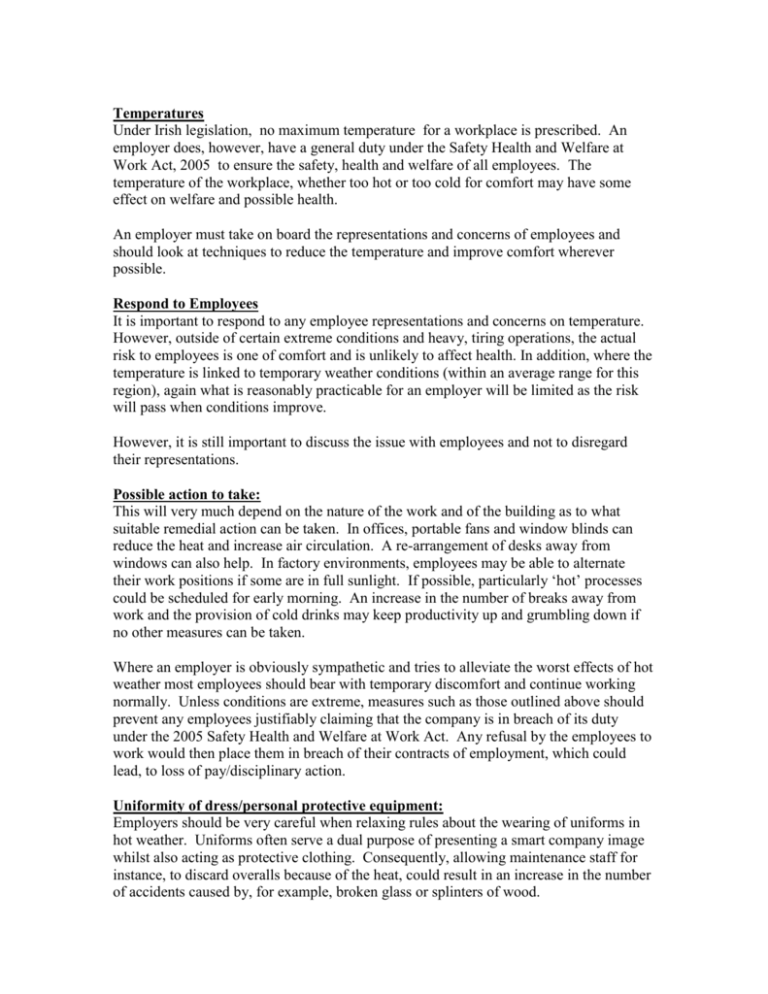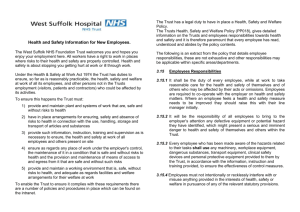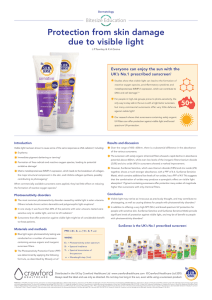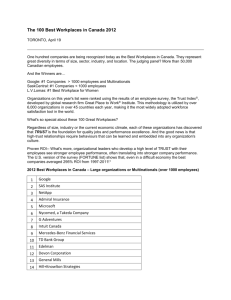Maximum temperatures
advertisement

Temperatures Under Irish legislation, no maximum temperature for a workplace is prescribed. An employer does, however, have a general duty under the Safety Health and Welfare at Work Act, 2005 to ensure the safety, health and welfare of all employees. The temperature of the workplace, whether too hot or too cold for comfort may have some effect on welfare and possible health. An employer must take on board the representations and concerns of employees and should look at techniques to reduce the temperature and improve comfort wherever possible. Respond to Employees It is important to respond to any employee representations and concerns on temperature. However, outside of certain extreme conditions and heavy, tiring operations, the actual risk to employees is one of comfort and is unlikely to affect health. In addition, where the temperature is linked to temporary weather conditions (within an average range for this region), again what is reasonably practicable for an employer will be limited as the risk will pass when conditions improve. However, it is still important to discuss the issue with employees and not to disregard their representations. Possible action to take: This will very much depend on the nature of the work and of the building as to what suitable remedial action can be taken. In offices, portable fans and window blinds can reduce the heat and increase air circulation. A re-arrangement of desks away from windows can also help. In factory environments, employees may be able to alternate their work positions if some are in full sunlight. If possible, particularly ‘hot’ processes could be scheduled for early morning. An increase in the number of breaks away from work and the provision of cold drinks may keep productivity up and grumbling down if no other measures can be taken. Where an employer is obviously sympathetic and tries to alleviate the worst effects of hot weather most employees should bear with temporary discomfort and continue working normally. Unless conditions are extreme, measures such as those outlined above should prevent any employees justifiably claiming that the company is in breach of its duty under the 2005 Safety Health and Welfare at Work Act. Any refusal by the employees to work would then place them in breach of their contracts of employment, which could lead, to loss of pay/disciplinary action. Uniformity of dress/personal protective equipment: Employers should be very careful when relaxing rules about the wearing of uniforms in hot weather. Uniforms often serve a dual purpose of presenting a smart company image whilst also acting as protective clothing. Consequently, allowing maintenance staff for instance, to discard overalls because of the heat, could result in an increase in the number of accidents caused by, for example, broken glass or splinters of wood. In August, 2003 when Ireland was basking in a heatwave, the Health and Safety Authority released the following press release: With temperatures soaring into the high 20’s, the Health and Safety Authority has urged workers to take extreme care. Dr. Dan Murphy, Manager of Occupational Health at the HSA, has warned those working outdoors to take appropriate precautions to protect their skin. “When working outdoors a sunscreen should be applied. Sunscreens should be used every day if you intend working out in the sun for more than 20 minutes. Sunscreens should be applied in the morning and reapplied after perspiring heavily”. However, Dr. Murphy emphasised that sunscreen is just one element of skin protection. “Although sunscreens are a very important part of maximum sun protection, wide brimmed hats, protective clothing and sun avoidance (between the hours of 10.00 a.m and 4.00 p.m.) are also important. With the right precautions, the chance of developing skin cancer can be greatly reduced”. The hazards associated with higher temperatures may not just apply to those working in outdoors and the Authority has taken this opportunity to remind employers and workers of the importance of adequate ventilation and shade in all workplaces. A comfortable temperature should be maintained in the workplace. In addition, windows, skylights or glass partitions in workplaces should not allow excessive temperatures to be reached during this hot weather. Curtains and blinds should be closed to avoid radiant heat, while at the same time, leaving windows open to allow a through draught. “For most workplaces, opening windows or doors will provide adequate ventilation. Where mechanical ventilation or air-conditioning is provided, the system should be checked regularly, kept clean and well maintained to prevent a growth of legionella bacteria or other organisms”. Dr. Murphy said: “Staff must be reminded that where a proper air conditioning system is installed, this will not function if any doors or windows are left open”. He added that staff should be encouraged to drink extra water regularly on very warm days. End of press release.









